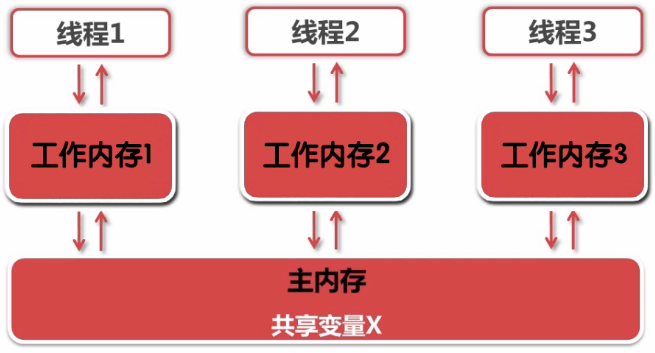在java语言里,java多线程的用法很多,这也正是学者们需要学习参考的基础知识,多线程用法较多,小编分享详解以下java基础教程内容。

1.创建线程
在Java中创建线程有两种方法:使用Thread类和使用Runnable接口。在使用Runnable接口时需要建立一个Thread实例。因此,无论是通过Thread类还是Runnable接口建立线程,都必须建立Thread类或它的子类的实例。Thread构造函数:
方法一:继承Thread类覆盖run方法
public class ThreadDemo1 {
public static void main(String[] args){
Demo d = new Demo();
d.start();
for(int i=0;i<60;i++){
System.out.println(Thread.currentThread().getName()+i);
}
}
}
class Demo extends Thread{
public void run(){
for(int i=0;i<60;i++){
System.out.println(Thread.currentThread().getName()+i);
}
}
}
方法二:
public class ThreadDemo2 {
public static void main(String[] args){
Demo2 d =new Demo2();
Thread t = new Thread(d);
t.start();
for(int x=0;x<60;x++){
System.out.println(Thread.currentThread().getName()+x);
}
}
}
class Demo2 implements Runnable{
public void run(){
for(int x=0;x<60;x++){
System.out.println(Thread.currentThread().getName()+x);
}
}
}
2.java多线程的生命周期
与人有生老病死一样,线程也同样要经历开始(等待)、运行、挂起和停止四种不同的状态。这四种状态都可以通过Thread类中的方法进行控制。下面给出了Thread类中和这四种状态相关的方法。
线程在建立后并不马上执行run方法中的代码,而是处于等待状态。线程处于等待状态时,可以通过Thread类的方法来设置线程不各种属性,如线程的优先级(setPriority)、线程名(setName)和线程的类型(setDaemon)等。
当调用start方法后,线程开始执行run方法中的编程语言代码。线程进入运行状态。可以通过Thread类的isAlive方法来判断线程是否处于运行状态。当线程处于运行状态时,isAlive返回true,当isAlive返回false时,可能线程处于等待状态,也可能处于停止状态。下面的代码演示了线程的创建、运行和停止三个状态之间的切换,并输出了相应的isAlive返回值。
一但线程开始执行run方法,就会一直到这个run方法执行完成这个线程才退出。但在线程执行的过程中,可以通过两个方法使线程暂时停止执行。这两个方法是suspend和sleep。在使用suspend挂起线程后,可以通过resume方法唤醒线程。而使用sleep使线程休眠后,只能在设定的时间后使线程处于就绪状态(在线程休眠结束后,线程不一定会马上执行,只是进入了就绪状态,等待着系统进行调度)。
在使用sleep方法时有两点需要注意:
1. sleep方法有两个重载形式,其中一个重载形式不仅可以设毫秒,而且还可以设纳秒(1,000,000纳秒等于1毫秒)。但大多数操作系统平台上的Java虚拟机都无法精确到纳秒,因此,如果对sleep设置了纳秒,Java虚拟机将取最接近这个值的毫秒。
2. 在使用sleep方法时必须使用throws或try{…}catch{…}。因为run方法无法使用throws,所以只能使用try{…}catch{…}。当在线程休眠的过程中,使用interrupt方法中断线程时sleep会抛出一个InterruptedException异常。sleep方法的定义如下:
- publicstaticvoid sleep(long millis) throws InterruptedException
- publicstaticvoid sleep(long millis, int nanos) throws InterruptedException
#p#分页标题#e#
有三种方法可以使终止线程。
1. 使用退出标志,使线程正常退出,也就是当run方法完成后线程终止。
2. 使用stop方法强行终止线程(这个方法不推荐使用,因为stop和suspend、resume一样,也可能发生不可预料的结果)。
3. 使用interrupt方法中断线程。
1. 使用退出标志终止线程
当run方法执行完后,线程就会退出。但有时run方法是永远不会结束的。如在服务端程序中使用线程进行监听客户端请求,或是其他的需要循环处理的任务。在这种情况下,一般是将这些任务放在一个循环中,如while循环。如果想让循环永远运行下去,可以使用while(true){…}来处理。但要想使while循环在某一特定条件下退出,最直接的方法就是设一个boolean类型的标志,并通过设置这个标志为true或false来控制while循环是否退出。下面给出了一个利用退出标志终止线程的例子。
join方法的功能就是使异步执行的线程变成同步执行。也就是说,当调用线程实例的start方法后,这个方法会立即返回,如果在调用start方法后后需要使用一个由这个线程计算得到的值,就必须使用join方法。如果不使用join方法,就不能保证当执行到start方法后面的某条语句时,这个线程一定会执行完。而使用join方法后,直到这个线程退出,程序才会往下执行。下面的代码演示了join的用法。
3.java多线程安全问题
问题原因:当多条语句在操作同一个线程共享数据时,一个线程对多条语句只执行了一部分,还没执行完,另一个线程参与进来执行,导致共享数据的错误。
解决办法:对多条操作共享数据的语句,只能让一个线程都执行完,在执行过程中,其他线程不执行。
同步代码块:
public class ThreadDemo3 {
public static void main(String[] args){
Ticket t =new Ticket();
Thread t1 = new Thread(t,”窗口一”);
Thread t2 = new Thread(t,”窗口二”);
Thread t3 = new Thread(t,”窗口三”);
Thread t4 = new Thread(t,”窗口四”);
t1.start();
t2.start();
t3.start();
t4.start();
}
}
class Ticket implements Runnable{
private int ticket =400;
public void run(){
while(true){
synchronized (new Object()) {
try {
Thread.sleep(1);
} catch (InterruptedException e) {
// TODO Auto-generated catch block
e.printStackTrace();
}
if(ticket<=0)
break;
System.out.println(Thread.currentThread().getName()+”—卖出”+ticket–);
}
}
}
}
#p#分页标题#e#
同步函数
public class ThreadDemo3 {
public static void main(String[] args){
Ticket t =new Ticket();
Thread t1 = new Thread(t,”窗口一”);
Thread t2 = new Thread(t,”窗口二”);
Thread t3 = new Thread(t,”窗口三”);
Thread t4 = new Thread(t,”窗口四”);
t1.start();
t2.start();
t3.start();
t4.start();
}
}
class Ticket implements Runnable{
private int ticket = 4000;
public synchronized void saleTicket(){
if(ticket>0)
System.out.println(Thread.currentThread().getName()+”卖出了”+ticket–);
}
public void run(){
while(true){
saleTicket();
}
}
}
同步函数锁是this 静态同步函数锁是class
java多线程间的通信
public class ThreadDemo3 {
public static void main(String[] args){
class Person{
public String name;
private String gender;
public void set(String name,String gender){
this.name =name;
this.gender =gender;
}
public void get(){
System.out.println(this.name+”….”+this.gender);
}
}
final Person p =new Person();
new Thread(new Runnable(){
public void run(){
int x=0;
while(true){
if(x==0){
p.set(“张三”, “男”);
}else{
p.set(“lili”, “nv”);
}
x=(x+1)%2;
}
}
}).start();
new Thread(new Runnable(){
public void run(){
while(true){
p.get();
}
}
}).start();
}
}
/*
张三….男
张三….男
lili….nv
lili….男
张三….nv
lili….男
*/
#p#分页标题#e#
修改上面代码
public class ThreadDemo3 {
public static void main(String[] args){
class Person{
public String name;
private String gender;
public void set(String name,String gender){
this.name =name;
this.gender =gender;
}
public void get(){
System.out.println(this.name+”….”+this.gender);
}
}
final Person p =new Person();
new Thread(new Runnable(){
public void run(){
int x=0;
while(true){
synchronized (p) {
if(x==0){
p.set(“张三”, “男”);
}else{
p.set(“lili”, “nv”);
}
x=(x+1)%2;
}
}
}
}).start();
new Thread(new Runnable(){
public void run(){
while(true){
synchronized (p) {
p.get();
}
}
}
}).start();
}
}
/*
lili….nv
lili….nv
lili….nv
lili….nv
lili….nv
lili….nv
张三….男
张三….男
张三….男
张三….男
*/
#p#分页标题#e#
等待唤醒机制
/*
*线程等待唤醒机制
*等待和唤醒必须是同一把锁
*/
public class ThreadDemo3 {
private static boolean flags =false;
public static void main(String[] args){
class Person{
public String name;
private String gender;
public void set(String name,String gender){
this.name =name;
this.gender =gender;
}
public void get(){
System.out.println(this.name+”….”+this.gender);
}
}
final Person p =new Person();
new Thread(new Runnable(){
public void run(){
int x=0;
while(true){
synchronized (p) {
if(flags)
try {
p.wait();
} catch (InterruptedException e) {
// TODO Auto-generated catch block
e.printStackTrace();
};
if(x==0){
p.set(“张三”, “男”);
}else{
p.set(“lili”, “nv”);
}
x=(x+1)%2;
flags =true;
p.notifyAll();
}
}
}
}).start();
new Thread(new Runnable(){
public void run(){
while(true){
synchronized (p) {
if(!flags)
try {
p.wait();
} catch (InterruptedException e) {
// TODO Auto-generated catch block
e.printStackTrace();
};
p.get();
flags =false;
p.notifyAll();
}
}
}
}).start();
}
}
#p#分页标题#e#
生产消费机制一
public class ThreadDemo4 {
private static boolean flags =false;
public static void main(String[] args){
class Goods{
private String name;
private int num;
public synchronized void produce(String name){
if(flags)
try {
wait();
} catch (InterruptedException e) {
// TODO Auto-generated catch block
e.printStackTrace();
}
this.name =name+”编号:”+num++;
System.out.println(“生产了….”+this.name);
flags =true;
notifyAll();
}
public synchronized void consume(){
if(!flags)
try {
wait();
} catch (InterruptedException e) {
// TODO Auto-generated catch block
e.printStackTrace();
}
System.out.println(“消费了******”+name);
flags =false;
notifyAll();
}
}
final Goods g =new Goods();
new Thread(new Runnable(){
public void run(){
while(true){
g.produce(“商品”);
}
}
}).start();
new Thread(new Runnable(){
public void run(){
while(true){
g.consume();
}
}
}).start();
}
}
#p#分页标题#e#
生产消费机制2
public class ThreadDemo4 {
private static boolean flags =false;
public static void main(String[] args){
class Goods{
private String name;
private int num;
public synchronized void produce(String name){
while(flags)
try {
wait();
} catch (InterruptedException e) {
// TODO Auto-generated catch block
e.printStackTrace();
}
this.name =name+”编号:”+num++;
System.out.println(Thread.currentThread().getName()+”生产了….”+this.name);
flags =true;
notifyAll();
}
public synchronized void consume(){
while(!flags)
try {
wait();
} catch (InterruptedException e) {
// TODO Auto-generated catch block
e.printStackTrace();
}
System.out.println(Thread.currentThread().getName()+”消费了******”+name);
flags =false;
notifyAll();
}
}
final Goods g =new Goods();
new Thread(new Runnable(){
public void run(){
while(true){
g.produce(“商品”);
}
}
},”生产者一号”).start();
new Thread(new Runnable(){
public void run(){
while(true){
g.produce(“商品”);
}
}
},”生产者二号”).start();
new Thread(new Runnable(){
public void run(){
while(true){
g.consume();
}
}
},”消费者一号”).start();
new Thread(new Runnable(){
public void run(){
while(true){
g.consume();
}
}
},”消费者二号”).start();
}
}
/*
消费者二号消费了******商品编号:48049
生产者一号生产了….商品编号:48050
消费者一号消费了******商品编号:48050
生产者一号生产了….商品编号:48051
消费者二号消费了******商品编号:48051
生产者二号生产了….商品编号:48052
消费者二号消费了******商品编号:48052
生产者一号生产了….商品编号:48053
消费者一号消费了******商品编号:48053
生产者一号生产了….商品编号:48054
消费者二号消费了******商品编号:48054
生产者二号生产了….商品编号:48055
消费者二号消费了******商品编号:48055
*/
java多线程的用法的详细讲解就说到这里了,想学习更多java视频教程的技术知识可在线学习观看!
